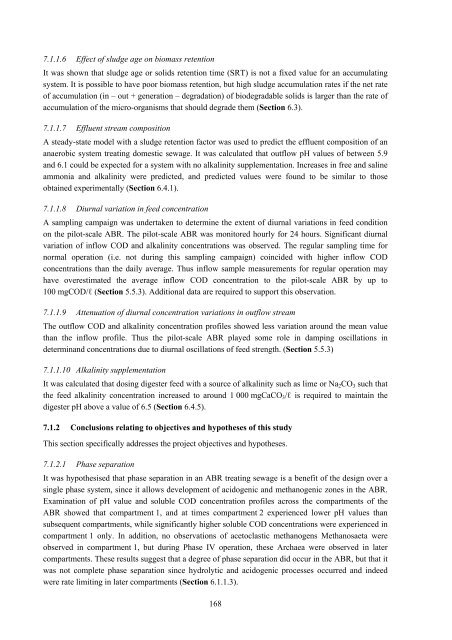analysis of a pilot-scale anaerobic baffled reactor treating domestic ...
analysis of a pilot-scale anaerobic baffled reactor treating domestic ...
analysis of a pilot-scale anaerobic baffled reactor treating domestic ...
Create successful ePaper yourself
Turn your PDF publications into a flip-book with our unique Google optimized e-Paper software.
7.1.1.6 Effect <strong>of</strong> sludge age on biomass retention<br />
It was shown that sludge age or solids retention time (SRT) is not a fixed value for an accumulating<br />
system. It is possible to have poor biomass retention, but high sludge accumulation rates if the net rate<br />
<strong>of</strong> accumulation (in – out + generation – degradation) <strong>of</strong> biodegradable solids is larger than the rate <strong>of</strong><br />
accumulation <strong>of</strong> the micro-organisms that should degrade them (Section 6.3).<br />
7.1.1.7 Effluent stream composition<br />
A steady-state model with a sludge retention factor was used to predict the effluent composition <strong>of</strong> an<br />
<strong>anaerobic</strong> system <strong>treating</strong> <strong>domestic</strong> sewage. It was calculated that outflow pH values <strong>of</strong> between 5.9<br />
and 6.1 could be expected for a system with no alkalinity supplementation. Increases in free and saline<br />
ammonia and alkalinity were predicted, and predicted values were found to be similar to those<br />
obtained experimentally (Section 6.4.1).<br />
7.1.1.8 Diurnal variation in feed concentration<br />
A sampling campaign was undertaken to determine the extent <strong>of</strong> diurnal variations in feed condition<br />
on the <strong>pilot</strong>-<strong>scale</strong> ABR. The <strong>pilot</strong>-<strong>scale</strong> ABR was monitored hourly for 24 hours. Significant diurnal<br />
variation <strong>of</strong> inflow COD and alkalinity concentrations was observed. The regular sampling time for<br />
normal operation (i.e. not during this sampling campaign) coincided with higher inflow COD<br />
concentrations than the daily average. Thus inflow sample measurements for regular operation may<br />
have overestimated the average inflow COD concentration to the <strong>pilot</strong>-<strong>scale</strong> ABR by up to<br />
100 mgCOD/ℓ (Section 5.5.3). Additional data are required to support this observation.<br />
7.1.1.9 Attenuation <strong>of</strong> diurnal concentration variations in outflow stream<br />
The outflow COD and alkalinity concentration pr<strong>of</strong>iles showed less variation around the mean value<br />
than the inflow pr<strong>of</strong>ile. Thus the <strong>pilot</strong>-<strong>scale</strong> ABR played some role in damping oscillations in<br />
determinand concentrations due to diurnal oscillations <strong>of</strong> feed strength. (Section 5.5.3)<br />
7.1.1.10 Alkalinity supplementation<br />
It was calculated that dosing digester feed with a source <strong>of</strong> alkalinity such as lime or Na2CO3 such that<br />
the feed alkalinity concentration increased to around 1 000 mgCaCO3/ℓ is required to maintain the<br />
digester pH above a value <strong>of</strong> 6.5 (Section 6.4.5).<br />
7.1.2 Conclusions relating to objectives and hypotheses <strong>of</strong> this study<br />
This section specifically addresses the project objectives and hypotheses.<br />
7.1.2.1 Phase separation<br />
It was hypothesised that phase separation in an ABR <strong>treating</strong> sewage is a benefit <strong>of</strong> the design over a<br />
single phase system, since it allows development <strong>of</strong> acidogenic and methanogenic zones in the ABR.<br />
Examination <strong>of</strong> pH value and soluble COD concentration pr<strong>of</strong>iles across the compartments <strong>of</strong> the<br />
ABR showed that compartment 1, and at times compartment 2 experienced lower pH values than<br />
subsequent compartments, while significantly higher soluble COD concentrations were experienced in<br />
compartment 1 only. In addition, no observations <strong>of</strong> acetoclastic methanogens Methanosaeta were<br />
observed in compartment 1, but during Phase IV operation, these Archaea were observed in later<br />
compartments. These results suggest that a degree <strong>of</strong> phase separation did occur in the ABR, but that it<br />
was not complete phase separation since hydrolytic and acidogenic processes occurred and indeed<br />
were rate limiting in later compartments (Section 6.1.1.3).<br />
168
















